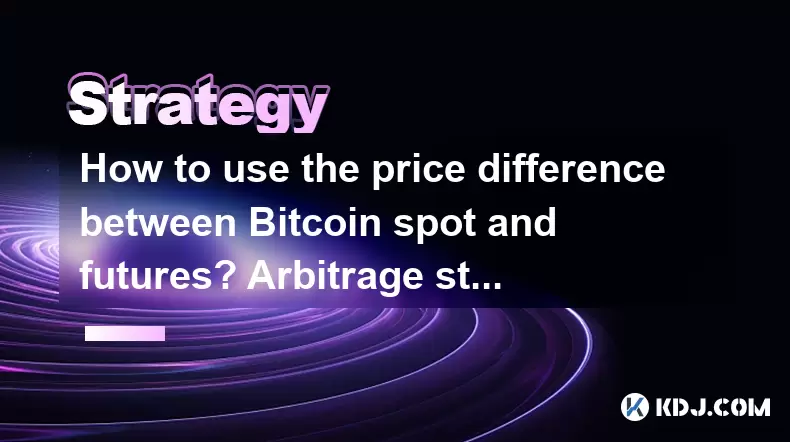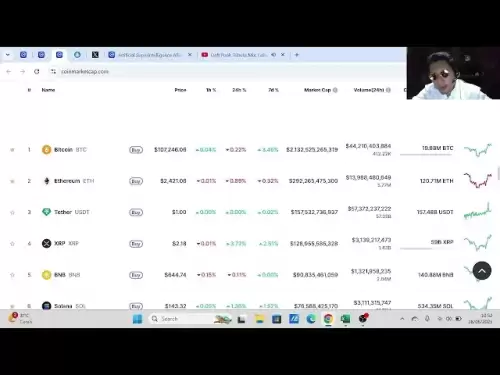-
 Bitcoin
Bitcoin $107,352.1067
0.28% -
 Ethereum
Ethereum $2,429.3531
-0.90% -
 Tether USDt
Tether USDt $1.0001
-0.02% -
 XRP
XRP $2.1894
4.62% -
 BNB
BNB $646.7968
0.36% -
 Solana
Solana $147.4290
4.03% -
 USDC
USDC $0.9998
-0.02% -
 TRON
TRON $0.2756
1.52% -
 Dogecoin
Dogecoin $0.1630
1.14% -
 Cardano
Cardano $0.5612
1.18% -
 Hyperliquid
Hyperliquid $37.0580
-0.05% -
 Bitcoin Cash
Bitcoin Cash $496.9410
-0.09% -
 Sui
Sui $2.7318
3.19% -
 Chainlink
Chainlink $13.1503
0.58% -
 UNUS SED LEO
UNUS SED LEO $9.0766
0.55% -
 Avalanche
Avalanche $17.7220
1.46% -
 Stellar
Stellar $0.2380
1.52% -
 Toncoin
Toncoin $2.8439
0.38% -
 Shiba Inu
Shiba Inu $0.0...01143
1.84% -
 Litecoin
Litecoin $85.8053
1.47% -
 Hedera
Hedera $0.1483
2.70% -
 Monero
Monero $314.3240
2.12% -
 Bitget Token
Bitget Token $4.6725
0.77% -
 Dai
Dai $1.0000
0.00% -
 Polkadot
Polkadot $3.3555
1.28% -
 Ethena USDe
Ethena USDe $1.0001
0.02% -
 Uniswap
Uniswap $7.0890
2.64% -
 Pi
Pi $0.5355
-3.40% -
 Pepe
Pepe $0.0...09393
1.06% -
 Aave
Aave $256.8136
-1.90%
How to quantify Bitcoin? Introduction to automatic trading strategies
Quantifying Bitcoin involves using metrics like price analysis, volatility, and market sentiment to inform automatic trading strategies, which require technical skills and backtesting.
May 13, 2025 at 07:42 am

Quantifying Bitcoin and implementing automatic trading strategies involves a blend of technical analysis, programming skills, and an understanding of market dynamics. This article will guide you through the process of quantifying Bitcoin's value using various metrics and introduce you to the world of automatic trading strategies, focusing specifically on Bitcoin.
Understanding Bitcoin Quantification
Quantifying Bitcoin involves measuring its value and performance using various financial and technical indicators. These metrics help traders and investors make informed decisions based on data rather than speculation.
One of the primary methods to quantify Bitcoin is through price analysis. By examining Bitcoin's historical price data, traders can identify trends and patterns that may influence future price movements. Tools like moving averages, Bollinger Bands, and Relative Strength Index (RSI) are commonly used to analyze Bitcoin's price.
Another aspect of Bitcoin quantification is volatility measurement. Bitcoin is known for its high volatility, which can be quantified using metrics such as the standard deviation of returns or the Average True Range (ATR). Understanding Bitcoin's volatility helps traders assess the risk associated with trading this cryptocurrency.
Market sentiment analysis is also crucial in quantifying Bitcoin. This involves analyzing social media trends, news sentiment, and other qualitative data to gauge the overall mood of the market. Tools like the Fear and Greed Index can provide insights into investor sentiment, which can be a powerful indicator of Bitcoin's potential price movements.
Setting Up an Automatic Trading Strategy
To implement an automatic trading strategy for Bitcoin, you will need to follow several steps. These steps involve choosing a trading platform, developing a trading algorithm, and backtesting your strategy to ensure its effectiveness.
Choose a Trading Platform: Select a platform that supports Bitcoin trading and offers API access for automated trading. Popular choices include Binance, Coinbase Pro, and Kraken. Ensure that the platform you choose has a robust API and a good reputation for reliability.
Develop a Trading Algorithm: Write a trading algorithm based on the metrics you used to quantify Bitcoin. This could involve using technical indicators like moving averages or RSI to trigger buy and sell signals. For example, a simple strategy might involve buying Bitcoin when its price crosses above a 50-day moving average and selling when it crosses below.
Backtest Your Strategy: Before deploying your strategy in live markets, backtest it using historical data. This will help you understand how your strategy would have performed in the past. Use tools like Backtrader or Quantopian to backtest your trading algorithm.
Deploy Your Strategy: Once you are satisfied with the backtesting results, deploy your strategy on the chosen trading platform. Monitor its performance and make adjustments as necessary.
Key Metrics for Bitcoin Quantification
When quantifying Bitcoin, several key metrics should be considered. These metrics provide a comprehensive view of Bitcoin's performance and can be used to inform trading decisions.
Price Metrics: Bitcoin's price is the most straightforward metric to quantify. Track metrics like the open, high, low, and close prices, as well as the volume of trades. These can be used to calculate other indicators like the Moving Average Convergence Divergence (MACD).
Volatility Metrics: As mentioned earlier, volatility can be measured using the standard deviation of returns or the Average True Range (ATR). These metrics help traders understand the risk associated with trading Bitcoin.
Market Sentiment Metrics: Tools like the Fear and Greed Index, social media sentiment analysis, and news sentiment analysis can provide insights into market sentiment. These metrics can be used to predict potential price movements based on investor mood.
Technical Indicators: Technical indicators like the Relative Strength Index (RSI), Bollinger Bands, and moving averages provide additional insights into Bitcoin's price trends and momentum. These can be used to generate buy and sell signals for an automatic trading strategy.
Implementing an Automatic Trading Strategy
Implementing an automatic trading strategy for Bitcoin involves several technical steps. Here is a detailed guide on how to set up and run an automatic trading strategy.
Choose a Programming Language: Select a programming language that is well-suited for financial analysis and trading. Python is a popular choice due to its extensive libraries and support for data analysis. Libraries like Pandas, NumPy, and Matplotlib can be used for data manipulation and visualization.
Set Up a Development Environment: Install the necessary software and libraries to develop your trading algorithm. This may include setting up a Python environment, installing trading libraries like ccxt or Binance API, and setting up a database to store historical data.
Write the Trading Algorithm: Use the metrics and indicators you identified earlier to write a trading algorithm. This algorithm should include logic for generating buy and sell signals based on the chosen indicators. For example, you might write a function that buys Bitcoin when the RSI is below 30 and sells when it is above 70.
Backtest the Algorithm: Use historical data to backtest your trading algorithm. This involves running the algorithm on past data to see how it would have performed. Adjust the parameters of your algorithm based on the backtesting results to optimize its performance.
Deploy the Algorithm: Once you are satisfied with the backtesting results, deploy your algorithm on a live trading platform. This involves connecting your algorithm to the trading platform's API and setting up the necessary parameters for live trading.
Monitor and Adjust: Monitor the performance of your algorithm in real-time and make adjustments as necessary. This may involve tweaking the parameters of your algorithm or adding new indicators to improve its performance.
Common Challenges in Bitcoin Quantification and Automatic Trading
Quantifying Bitcoin and implementing automatic trading strategies come with several challenges. Understanding these challenges can help you develop more robust strategies and improve your trading performance.
Data Quality and Availability: Accessing high-quality, real-time data can be challenging. Ensure that you have reliable data sources and consider the impact of data latency on your trading strategy.
Market Volatility: Bitcoin's high volatility can lead to significant price swings, which can affect the performance of your trading strategy. Develop strategies that can handle high volatility and consider using risk management techniques to mitigate potential losses.
Overfitting: When backtesting your trading algorithm, be careful not to overfit it to historical data. Overfitting can lead to poor performance in live markets. Use techniques like cross-validation to ensure that your algorithm generalizes well to new data.
Regulatory and Security Concerns: Trading Bitcoin involves navigating regulatory and security challenges. Ensure that you comply with relevant regulations and implement robust security measures to protect your trading accounts and data.
FAQs
Q: Can I use machine learning to improve my Bitcoin trading strategy?
A: Yes, machine learning can be used to enhance Bitcoin trading strategies. Techniques like regression analysis, classification, and reinforcement learning can be applied to predict price movements and optimize trading decisions. However, be aware of the risk of overfitting and ensure that your models are robust and generalize well to new data.
Q: How important is risk management in Bitcoin trading?
A: Risk management is crucial in Bitcoin trading due to its high volatility. Implementing stop-loss orders, diversifying your portfolio, and using position sizing techniques can help manage risk and protect your capital. Always consider the potential downside of your trades and have a plan in place to mitigate losses.
Q: What are the advantages of using an automatic trading strategy for Bitcoin?
A: Automatic trading strategies offer several advantages, including the ability to execute trades quickly and consistently, the removal of emotional bias from trading decisions, and the ability to backtest and optimize strategies using historical data. These advantages can lead to improved trading performance and better risk management.
Q: How can I ensure the security of my Bitcoin trading account?
A: To ensure the security of your Bitcoin trading account, use strong, unique passwords, enable two-factor authentication, and regularly monitor your account for suspicious activity. Additionally, consider using hardware wallets to store your Bitcoin offline and protect against hacking attempts.
Disclaimer:info@kdj.com
The information provided is not trading advice. kdj.com does not assume any responsibility for any investments made based on the information provided in this article. Cryptocurrencies are highly volatile and it is highly recommended that you invest with caution after thorough research!
If you believe that the content used on this website infringes your copyright, please contact us immediately (info@kdj.com) and we will delete it promptly.
- SEI Mirroring Solana: Price Spikes and the Next Big Crypto?
- 2025-06-28 20:52:13
- PENGU Price Surges: Are Whales Targeting $0.0149?
- 2025-06-28 20:30:12
- Notcoin's Wild Ride: Price Swings, Market Cap, and What's Next
- 2025-06-28 20:30:12
- COMP Price Wobbles as a16z Moves Tokens Amid Crypto Jitters
- 2025-06-28 20:52:13
- Bitcoin, XRP, and Macro Trends: Navigating the Crypto Landscape in 2025 and Beyond
- 2025-06-28 20:55:12
- Navigating Offshore Casinos: A Safe Haven for US Players?
- 2025-06-28 20:55:12
Related knowledge

What are the skills of Bitcoin option hedging? Practical case sharing
Jun 24,2025 at 04:01pm
Understanding Bitcoin Option HedgingBitcoin option hedging is a risk management strategy used by traders and investors to protect their positions in the volatile cryptocurrency market. By using options, individuals can limit potential losses while retaining the opportunity for profit. In essence, it allows one to insulate against adverse price movements...

How to use the price difference between Bitcoin spot and futures? Arbitrage strategy
Jun 20,2025 at 02:56pm
Understanding Bitcoin Spot and Futures MarketsTo effectively leverage arbitrage opportunities between Bitcoin spot and futures markets, it's essential to understand the fundamental differences between these two types of markets. The spot market refers to the direct buying and selling of Bitcoin for immediate delivery at the current market price. In cont...

How to increase DeFi lending income? Strategy and risk analysis
Jun 24,2025 at 02:08pm
Understanding DeFi Lending and Its Income PotentialDeFi (Decentralized Finance) lending has emerged as a popular way to earn passive income in the cryptocurrency space. Unlike traditional banking systems, DeFi lending platforms allow users to lend their crypto assets directly to borrowers without intermediaries. The lenders earn interest based on the su...

How to operate cryptocurrency cross-market arbitrage? Practical analysis
Jun 23,2025 at 04:01am
Understanding Cryptocurrency Cross-Market ArbitrageCryptocurrency cross-market arbitrage involves taking advantage of price differences for the same digital asset across different exchanges. The core idea is to buy low on one exchange and sell high on another, capturing the profit from the discrepancy. This strategy relies heavily on real-time market da...

How to make profits from high-frequency cryptocurrency trading? Sharing core skills
Jun 19,2025 at 05:07pm
Understanding High-Frequency Cryptocurrency TradingHigh-frequency trading (HFT) in the cryptocurrency market involves executing a large number of trades at extremely fast speeds, often within milliseconds. This method relies on small price discrepancies across exchanges or within a single exchange’s order book. Traders use complex algorithms and ultra-l...

What are the methods of cryptocurrency quantitative trading? Detailed analysis
Jun 22,2025 at 11:07pm
Understanding the Core of Cryptocurrency Quantitative TradingCryptocurrency quantitative trading refers to the use of mathematical models and algorithms to execute trades in the digital asset market. Unlike traditional discretionary trading, which relies heavily on human judgment, quantitative trading leverages data-driven strategies to identify profita...

What are the skills of Bitcoin option hedging? Practical case sharing
Jun 24,2025 at 04:01pm
Understanding Bitcoin Option HedgingBitcoin option hedging is a risk management strategy used by traders and investors to protect their positions in the volatile cryptocurrency market. By using options, individuals can limit potential losses while retaining the opportunity for profit. In essence, it allows one to insulate against adverse price movements...

How to use the price difference between Bitcoin spot and futures? Arbitrage strategy
Jun 20,2025 at 02:56pm
Understanding Bitcoin Spot and Futures MarketsTo effectively leverage arbitrage opportunities between Bitcoin spot and futures markets, it's essential to understand the fundamental differences between these two types of markets. The spot market refers to the direct buying and selling of Bitcoin for immediate delivery at the current market price. In cont...

How to increase DeFi lending income? Strategy and risk analysis
Jun 24,2025 at 02:08pm
Understanding DeFi Lending and Its Income PotentialDeFi (Decentralized Finance) lending has emerged as a popular way to earn passive income in the cryptocurrency space. Unlike traditional banking systems, DeFi lending platforms allow users to lend their crypto assets directly to borrowers without intermediaries. The lenders earn interest based on the su...

How to operate cryptocurrency cross-market arbitrage? Practical analysis
Jun 23,2025 at 04:01am
Understanding Cryptocurrency Cross-Market ArbitrageCryptocurrency cross-market arbitrage involves taking advantage of price differences for the same digital asset across different exchanges. The core idea is to buy low on one exchange and sell high on another, capturing the profit from the discrepancy. This strategy relies heavily on real-time market da...

How to make profits from high-frequency cryptocurrency trading? Sharing core skills
Jun 19,2025 at 05:07pm
Understanding High-Frequency Cryptocurrency TradingHigh-frequency trading (HFT) in the cryptocurrency market involves executing a large number of trades at extremely fast speeds, often within milliseconds. This method relies on small price discrepancies across exchanges or within a single exchange’s order book. Traders use complex algorithms and ultra-l...

What are the methods of cryptocurrency quantitative trading? Detailed analysis
Jun 22,2025 at 11:07pm
Understanding the Core of Cryptocurrency Quantitative TradingCryptocurrency quantitative trading refers to the use of mathematical models and algorithms to execute trades in the digital asset market. Unlike traditional discretionary trading, which relies heavily on human judgment, quantitative trading leverages data-driven strategies to identify profita...
See all articles
























































































